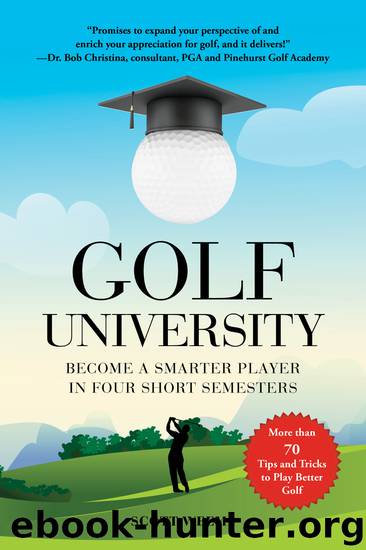Golf University by Scott Weems

Author:Scott Weems
Language: eng
Format: epub
ISBN: 9781510743069
Publisher: Skyhorse
Published: 2019-02-26T05:00:00+00:00
READING LIST
Deliberate Practice
Ericsson, K., Krampe, R., and Romer, C. (1993). The Role of Deliberate Practice in the Acquisition of Expert Performance. Psychological Review, 100, 363–406.
Implicit Learning
Chauvel, G., Maquestiaux, F., Ruthruff, E., Didierjean, A., and Hartley, A. (2013). Novice Motor Performance: Better not to Verbalize. Psychonomics Bulletin Review, 20, 177–183.
4Fery, Y. and Ponserre, S. (2001). Enhancing the Control of Force in Putting by Video Game Training. Ergonomics, 44, 1025–1037.
Hwang, G. (2003). An Examination of the Impact of Introducing Greater Contextual Interference During Practice on Learning to Golf Putt (PhD dissertation, Texas A&M University).
3Ishikura, T. (2008). Reduced Relative Frequency of Knowledge of Results Without Visual Feedback in Learning a Golf-Putting Task. Perceptual and Motor Skills, 106, 225–233.
1Maxwell, J., Masters, R., Kerr, E., and Weedon, E. (2001). The Implicit Benefit of Learning Without Errors. The Quarterly Journal of Experimental Psychology, 54, 1049–1068.
Poolton, J., Masters, R., and Maxwell, J. (2005). The Relationship Between Initial Errorless Learning Conditions and Subsequent Performance. Human Movement Science, 24, 362–378.
2Porter, J. and Magill, R. (2010). Systematically Increasing Contextual Interference is Beneficial for Learning Sport Skills. Journal of Sports Sciences, 28, 1277–1285.
Teaching and Learning Styles
Arnold, G. (1997). Creating a Methodology for Teaching the Golf Swing (MA thesis, Canadian Professional Golfers’ Association).
Christina, R. and Alpenfels, E. (2002). Why Does Traditional Training Fail to Optimize Playing Performance? In Thain, E. (Ed.), Science and Golf IV: Proceedings of the World Scientific Congress of Golf (pp. 231–245). New York: Routledge.
5Lutz, R. (1998). The Effects of Traditional and Learning-Centered Golf Instruction on Skill Development and Attitudes Toward Golf. In Farrally, M. and Cochran, A. (Ed.), Science and Golf III: Proceedings of the World Scientific Congress of Golf (pp. 225–233). Champaign, IL: Human Kinetics.
Rancourt, R. and Searle, R. (1990). Golfers Do It with Style: Epistemic Orientations of Golf Instructors and Students. In A.J. Cochran (Ed.), Science and Golf: Proceedings of the First World Scientific Congress of Golf (pp. 105–110). New York: E&FN Spon.
6Webster, C. (2006). A Comparison of Expert and Novice Golf Instructors from a Communication Perspective (PhD dissertation, University of Georgia).
Timing Training
Chan, C., Tzu-Ling, Y., and Wen-Tzu, T (2010). Temporal Pattern of Distance Control in Golf Putting after Rhythm Training. Paper presented at the 6th Annual World Congress on Biomechanics, Singapore.
Libkuman, T., Otani, H., and Steger, N. (2002). Training in Timing Improves Accuracy in Golf. The Journal of General Psychology, 129, 77–96.
Sommer, M. and Ronnqvist, L. (2009). Improved Motor-Timing: Effects of Synchronized Metronome Training on Golf Shot Accuracy. Journal of Sports Science and Medicine, 8, 648–656.
Download
This site does not store any files on its server. We only index and link to content provided by other sites. Please contact the content providers to delete copyright contents if any and email us, we'll remove relevant links or contents immediately.
Unstoppable by Maria Sharapova(3118)
The Inner Game of Tennis by W. Timothy Gallwey(2990)
Urban Outlaw by Magnus Walker(2949)
Crazy Is My Superpower by A.J. Mendez Brooks(2859)
The Social Psychology of Inequality by Unknown(2309)
The Fight by Norman Mailer(2158)
Unstoppable: My Life So Far by Maria Sharapova(2128)
Going Long by Editors of Runner's World(1920)
Accepted by Pat Patterson(1917)
Motorcycle Man by Kristen Ashley(1860)
The Sports Gene: Inside the Science of Extraordinary Athletic Performance by David Epstein(1821)
The Happy Runner by David Roche(1819)
Backpacker the Complete Guide to Backpacking by Backpacker Magazine(1815)
Sea Survival Handbook by Keith Colwell(1794)
Futebol by Alex Bellos(1784)
Mind Fuck by Manna Francis(1743)
Peak: Secrets from the New Science of Expertise by Anders Ericsson & Robert Pool(1662)
Endure by Alex Hutchinson(1604)
The Call of Everest by Conrad Anker(1549)
